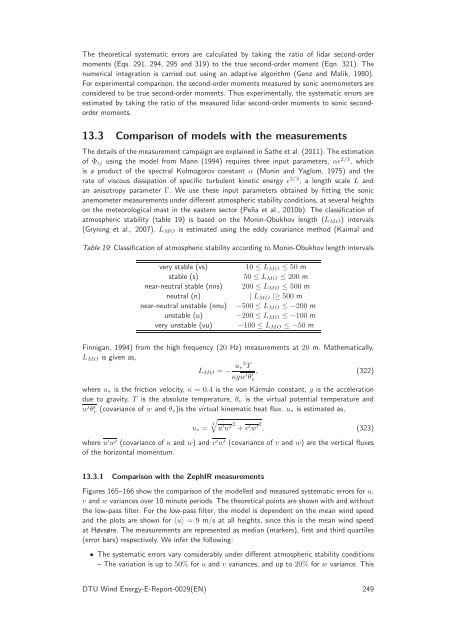Publishers version - DTU Orbit
Publishers version - DTU Orbit
Publishers version - DTU Orbit
You also want an ePaper? Increase the reach of your titles
YUMPU automatically turns print PDFs into web optimized ePapers that Google loves.
The theoretical systematic errors are calculated by taking the ratio of lidar second-order<br />
moments (Eqs. 291, 294, 295 and 319) to the true second-order moment (Eqn. 321). The<br />
numerical integration is carried out using an adaptive algorithm (Genz and Malik, 1980).<br />
For experimental comparison, the second-order moments measured by sonic anemometers are<br />
considered to be true second-order moments. Thus experimentally, the systematic errors are<br />
estimated by taking the ratio of the measured lidar second-order moments to sonic secondorder<br />
moments.<br />
13.3 Comparison of models with the measurements<br />
Thedetails ofthe measurementcampaignare explained inSathe et al. (2011).Theestimation<br />
of Φij using the model from Mann (1994) requires three input parameters, αǫ 2/3 , which<br />
is a product of the spectral Kolmogorov constant α (Monin and Yaglom, 1975) and the<br />
rate of viscous dissipation of specific turbulent kinetic energy ǫ 2/3 , a length scale L and<br />
an anisotropy parameter Γ. We use these input parameters obtained by fitting the sonic<br />
anemometermeasurements underdifferent atmospheric stabilityconditions,at several heights<br />
on the meteorological mast in the eastern sector (Peña et al., 2010b). The classification of<br />
atmospheric stability (table 19) is based on the Monin-Obukhov length (LMO) intervals<br />
(Gryning et al., 2007). LMO is estimated using the eddy covariance method (Kaimal and<br />
Table 19: Classification of atmospheric stability according to Monin-Obukhovlength intervals<br />
very stable (vs) 10 ≤ LMO ≤ 50 m<br />
stable (s) 50 ≤ LMO ≤ 200 m<br />
near-neutral stable (nns) 200 ≤ LMO ≤ 500 m<br />
neutral (n) | LMO |≥ 500 m<br />
near-neutral unstable (nnu) −500 ≤ LMO ≤ −200 m<br />
unstable (u) −200 ≤ LMO ≤ −100 m<br />
very unstable (vu) −100 ≤ LMO ≤ −50 m<br />
Finnigan, 1994) from the high frequency (20 Hz) measurements at 20 m. Mathematically,<br />
LMO is given as,<br />
LMO = − u∗ 3T κgw ′ θ ′ , (322)<br />
v<br />
where u∗ is the friction velocity, κ = 0.4 is the von Kármán constant, g is the acceleration<br />
due to gravity, T is the absolute temperature, θv is the virtual potential temperature and<br />
w ′ θ ′ v (covariance of w and θv)is the virtual kinematic heat flux. u∗ is estimated as,<br />
<br />
u∗ = 4<br />
u ′ w ′2 +v ′ w ′2 , (323)<br />
where u ′ w ′ (covariance of u and w) and v ′ w ′ (covariance of v and w) are the vertical fluxes<br />
of the horizontal momentum.<br />
13.3.1 Comparison with the ZephIR measurements<br />
Figures 165–166 show the comparison of the modelled and measured systematic errors for u,<br />
v and w variances over 10 minute periods. The theoretical points are shown with and without<br />
the low-pass filter. For the low-pass filter, the model is dependent on the mean wind speed<br />
and the plots are shown for 〈u〉 = 9 m/s at all heights, since this is the mean wind speed<br />
at Høvsøre. The measurements are represented as median (markers), first and third quartiles<br />
(error bars) respectively. We infer the following:<br />
• The systematic errors vary considerably under different atmospheric stability conditions<br />
– The variation is up to 50% for u and v variances, and up to 20% for w variance. This<br />
<strong>DTU</strong> Wind Energy-E-Report-0029(EN) 249

















